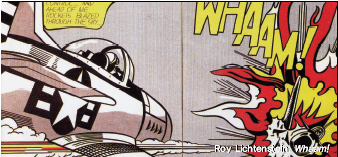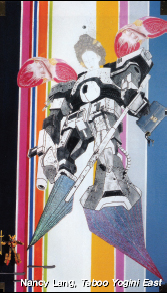 Coca-Cola is a mass produced product that represents modern industrial society, and we can see it and drink it everyday. Some artists use images and objects from popular culture including Coca-Cola bottles. These artworks are called “pop art.”
Coca-Cola is a mass produced product that represents modern industrial society, and we can see it and drink it everyday. Some artists use images and objects from popular culture including Coca-Cola bottles. These artworks are called “pop art.”What is Pop Art?
Pop art is artwork that uses popular cultural images such as billboards, comic strips, advertisements and supermarket products. The term “pop art” was first used by the English art critic Lawrence Alloway in 1954. The first piece of pop art was a collage entitled Just What is it that Makes Today's Homes so Different, so Appealing? by the English pop artist Richard Hamilton; however, pop art developed in the United States of America. America developed its industrial society after World War Ⅱ. That time coincided with the development of popular culture. The economic and cultural atmosphere influenced the artistic community. Abstract expressionism, which considers excessive subjectivism important, vanished, and pop art, which expresses realistic material things, arose.
 Famous Pop Artists
Famous Pop ArtistsA representative and popular pop artist was Andy Warhol (1928 ~ 1987). He asserted the industrialization of art and created his paintings through his own mechanical procedures of production. He chose common objects to express his art like Coca-Cola bottles and Campbell's soup cans, and popular stars like Marilyn Monroe, Elvis Presley, and Jacqueline Kennedy. Then he copied his artworks several times with little modification. Finally, he produced his paintings in large amounts. The traits of his works can be classified into three categories: reiterate images, commercial images and no individual images.
Andy Warhol had a famous reputation because of his unique artistic creativity that opposed other traditional artists. He wore peculiar clothes and dyed his hair. He enjoyed showing off in interviews, lectures, and parties. He called his atelier “factory,” and his assistants painted his works instead of him. He also participated in film production and founded magazines. Warhol grasped the attribute of industrial society and established the concept of business art. He said, “Earning money is art, working is art, and business is the best art.”
 Another famous pop artist was Roy Lichtenstein (1923 ~ 1997). He was the pop artist who expressed everyday life to the American people using popular comics and commercial advertising. He actively reflected the attributes of mass media and the consumption culture. Lichtenstein used extreme hyperbole, social satire, and free expression of cartoons. His early works featured famous characters such as Mickey Mouse, Donald Duck, and Popeye. He also used peculiar exclamation, onomatopoeia, or sentences that explain stories with a comic image. He especially stimulated the curiosity and subconsciousness of audiences using narrative balloons. Roy Lichtenstein's unique work style was to choose trite and vulgar subjects such as love, violence, and war and express them using thick outlines, vivid colors, and dot patterns. He also introduced commodities, daily items, and advertising images in his art.
Another famous pop artist was Roy Lichtenstein (1923 ~ 1997). He was the pop artist who expressed everyday life to the American people using popular comics and commercial advertising. He actively reflected the attributes of mass media and the consumption culture. Lichtenstein used extreme hyperbole, social satire, and free expression of cartoons. His early works featured famous characters such as Mickey Mouse, Donald Duck, and Popeye. He also used peculiar exclamation, onomatopoeia, or sentences that explain stories with a comic image. He especially stimulated the curiosity and subconsciousness of audiences using narrative balloons. Roy Lichtenstein's unique work style was to choose trite and vulgar subjects such as love, violence, and war and express them using thick outlines, vivid colors, and dot patterns. He also introduced commodities, daily items, and advertising images in his art. Korean Pop Art
Korean Pop ArtInterest in pop art is increasing in Korea. A famous Korean pop artist is Nancy Lang. She paints robot bodies with human faces. She calls these paintings “Taboo Yogini” (Yogini indicates a spiritual messenger who exists between man and God). We often see her on TV or in magazines.
Places at which pop art can be viewed are increasing in Korea. People can view Spring, a sculpture by pop artists Claes Oldenburg and his wife, Coosje van Bruggen in Chonggyenchon, Seoul. Two interior ribbons, one red and one blue, based on the colors of the Korean flag and suggestive of the double helix of DNA represent the unity of opposites in nature and the human spirit. As visitors look into the yellow illuminated interior of the sculpture from the edge of the opening, they see water in motion as if rising from a spring. Last year, people could view Andy Warhol's pop art and contemporary Korean pop art including Nancy Lang at Ssamzie Gallery (Ssamziegil was introduced in Gazette No. 121). Ssamziegil displayed artworks placed throughout the complex. Seoul National University also has displayed Andy Warhol's artworks. In addition, Leeum Museum will display Andy Warhol's artworks.








